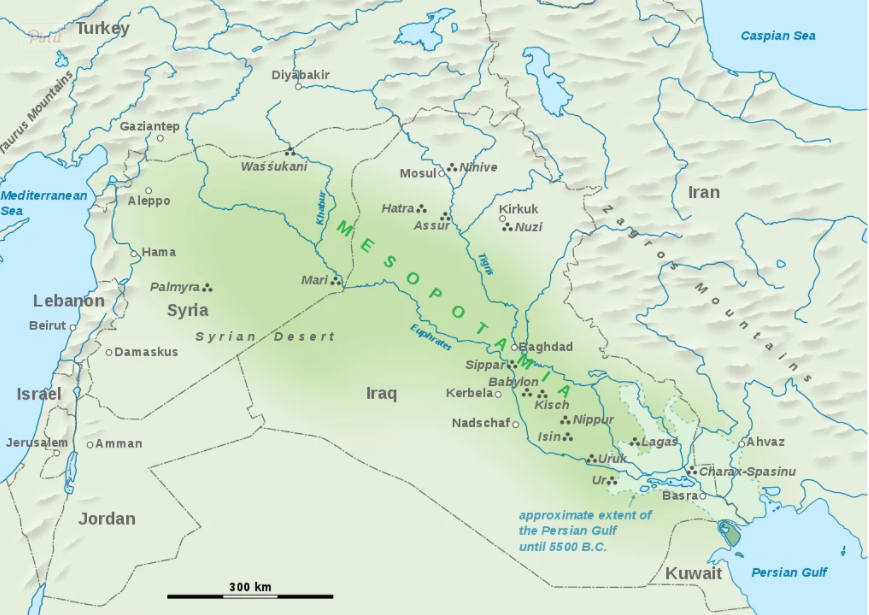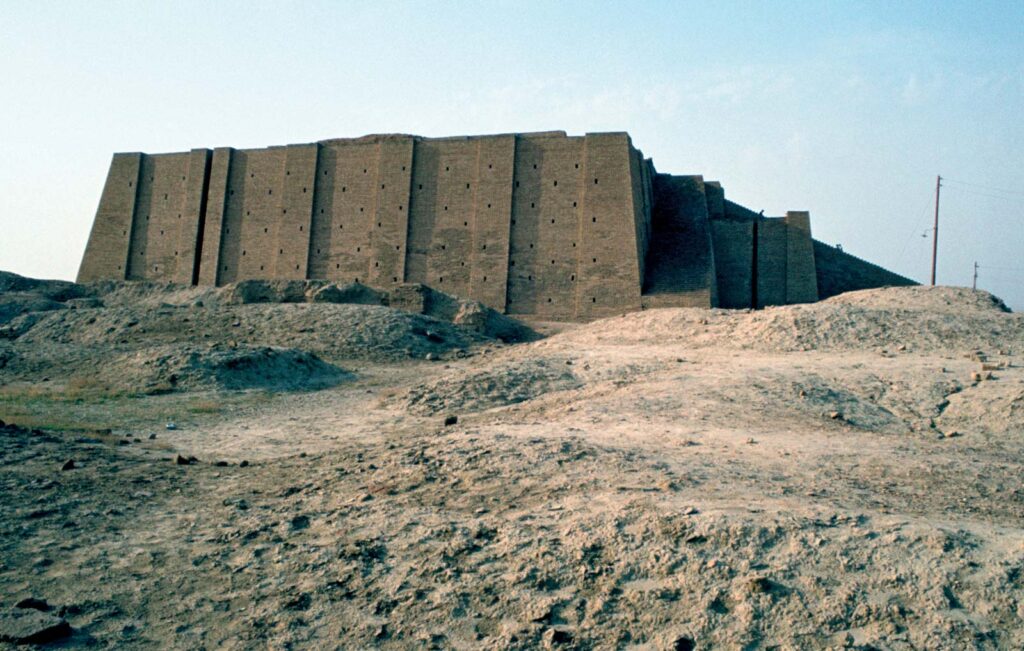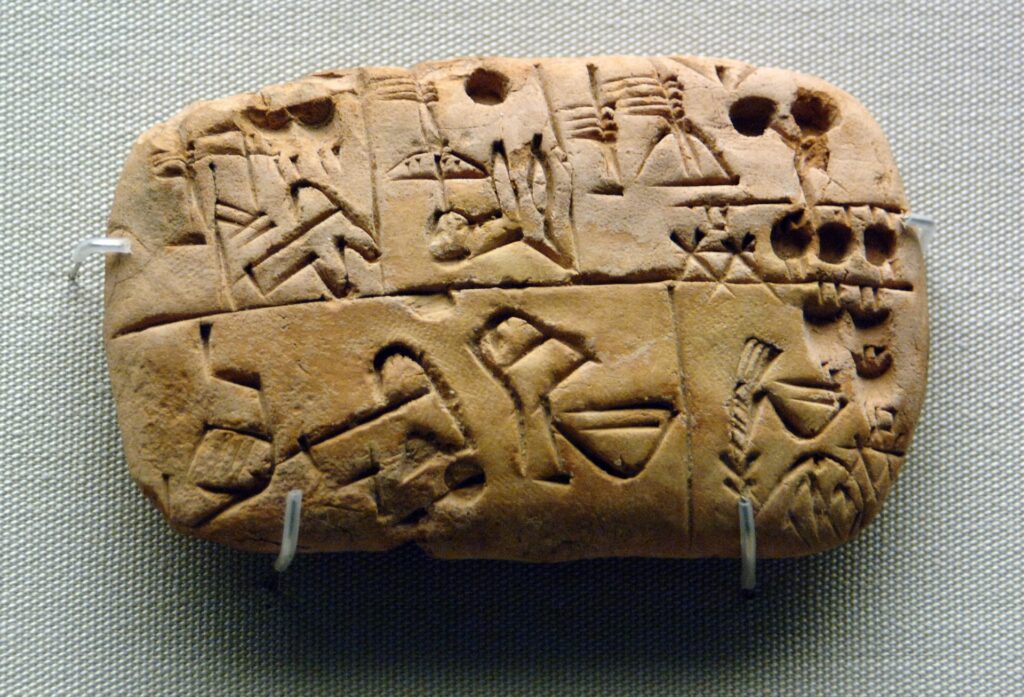តំបន់ Mesopotamia ដែលអ្នកស្រាវជ្រាវចាត់ទុកថា ជាអរិយធម៌ចាស់ជាងគេក្នុងចំណោមអរិយធម៌ដំបូងៗក្នុងប្រវត្តិពិភពលោកដែលបច្ចុប្បន្នស្ថិតនៅរវាងប្រទេស ស៊ីរី គូវេត និងអ៊ីរ៉ាក់។
ពាក្យ Mesopotamia គឺមានន័យថា “ចន្លោះទន្លេ” ដោយអរិយធម៍នេះមានការរីកចម្រើនអរិយធម៌ខ្លួននៅតំបន់ន្លោះទន្លេពីរ គឺ ទន្លេ Tigris និង ទន្លេ Euphrates។ ការជ្រើសរើសតាំងទីនៅតាមតំបន់ទន្លេនេះ គឺស្របទៅតាមវិស័យកសិកម្ម នេសាទ និងការចិញ្ចឹមសត្វ ដែលពឹងផ្អែកទៅលើប្រភពទឹក។
នៅក្នុងអរិយធម៌នេះមានអាណាចក្រធំ៥ធំៗគឺ Sumer, Akkad Babylon Assyrian និង Persian។ អាណាចក្រ Akkad ត្រូវបានបែងចែកចេញពីរផ្សេងទៀត គឺអាណាចក្រ Assyrian និង Babylon។ ទីក្រុងដំបូងនៃអរិយធម៌នេះ គឺមានឈ្មោះថា Ur ដែលមានអាយុកាលប្រមាណ៣៨០០ឆ្នាំ មុនគ.ស. ដោយមានការរៀបចំហេដ្នារចនាសម្ព័ន្ឋដូចជា មានកំពែងពីដី ផ្ទះប្រជាជនកសាងតាមអក្ស័បណ្តោយថ្ងៃ ទទឹងថ្ងៃ ហើយប្រាសាទដែលល្បីល្បាញជាង គឺមានឈ្មោះថា Ziggurat សម្រាប់ឧទ្ទិសដល់អធិទេពមួយដែលមានឈ្មោះថា Anu ( Sky god)។ ប្រាសាទ Ziggurat គឺសម្រាប់ឧទ្ទិសដល់អធិទេពផ្សេងៗដែលមនុស្សក្នុងអរិយធម៍នេះគោរព។
ក្រុមមនុស្សនៅក្នុងអរិយធម៌នេះ បានបង្កើតជាទម្រង់អក្សរដែលហៅថា Cuneiform ដែលមនុស្សក្នុងអរិយធម៌នេះ បានបង្កើតឡើងប្រមាណ៣២០០ឆ្នាំមុនគ.ស។ ការបង្កើតអក្សរ គឺត្រូវបានគេចាត់ទុកថាជាដែនកំណត់នៃសម័យកាលបុរេប្រវត្តិ និងប្រវត្តិសាស្រ្ត ប៉ុន្តែការកំណត់ដែនបុរេប្រវត្តិសាស្រ្ត គឺមិនត្រូវបានកំណត់ដូចគ្នាទូទៅពិភពលោកនោះទេ។ ក្នុងចំណោមអាណាចក្រធំទាំងបីនោះ អាណាចក្រ Babylon ដែលគេស្គាល់ច្រើនជាងគេ ហើយអាណាចក្រនេះ មានរាជធានីនៅក្បែរទីក្រុងបាដាត នៃប្រទេស អ៊ីរ៉ាក់បច្ចុប្បន្នហើយអាណាចក្រ Babylonសម័យបុរាណមានមហាក្សត្រមួយអង្គ គឺព្រះនាម Hammurabi ដែលមានឈ្មោះល្បីល្បាញក្នុងការបង្កើតច្បាប់ក្រមដែលអ្នកស្រាវជ្រាវហៅថា ច្បាប់ Hammurabi ដែលបានរកឃើញនៅតំបន់ Susa ហើយសព្វថ្ងៃរក្សាទុកនៅសារមន្ទីរ Louvre នៃប្រទេសបារាំង។ ប៉ុន្តែភាពជោគជ័យរបស់អរិយធម៌មេសូប៉ូតាមីក៏បានបញ្ចប់ ដោយសារការដួលរលំអាណាចក្រ Babylone ពីការឈ្លានពានទឹកដី នៅឆ្នាំ ៥៣៩មុនគ.ស ពីស្តេចនៃចក្រភពពែក បានធ្វើការដណ្តើមយក Babylone និងពង្រើកអំណាចរបស់ខ្លួន ក្នុងការកាន់កាប់តំបន់នៃអរិយធម៌មេសូប៉ូតាមីទាំងមូល ហើយបានកាន់កាប់តំបន់ទាំងនោះអស់ច្រើនសតវត្ស។
តាមរយៈការស្រាវជ្រាវបុរាណវិទ្យា ចាប់តាំងពីទសវត្សទី៨០ ពោល គឺចាប់ពីឆ្នាំ១៨៤២មក អ្នកបុរាណវិទូបានកំណាយរកឃើញភស្តុតាងជាច្រើននៃតំបន់អរិយធម៌នេះ ដែលភស្តុតាងទាំងនោះមានដូចជា សិលាចារឹក , កុលាលភាជន៍ , បដិមា និងការរកឃើញរចនាសម្ព័ន្ឋក្រុងបុរាណដែរ ដែលភស្តុងចាស់ជាងគេមានអាយុកាលប្រមាណ ៣២០០ឆ្នាំ មុនគ.ស. និងមានវត្ថុសិល្បៈជាច្រើនទៀតបានតម្កល់ទុកនៅសារមន្ទីរបរទេស ជាពិសេសនៅសារមន្ទីល្លូវនៅទីក្រុងប៉ារីសប្រទេសបារាំង។ សំណង់នៅតំបន់មេសូប៉ូតាមីភាគច្រើនកសាងពីដីឥដ្ឋដែលមិនអាចនៅរហូតដល់បច្ចុប្បន្ន។
———————————————–
Mesopotamian Civilization
Mesopotamia means “between or in the middle of the river”, with civilization flourishing in the region between two rivers, the Tigris and the Euphrates. The choice of location along the river is in line with the agriculture, fisheries, and animal husbandry sectors that depend on water sources.
Mesopotamia is a historical region that researchers consider to be one of the earliest civilizations in world history, is currently located between Syria, Kuwait and Iraq.
In this civilization, there are five great empires: Sumer, Akkad, Babylon, Assyrian, and Persian. The Akkad Empire was divided into two kingdoms, namely the Assyrian and Babylon Empires. The first city of this civilization was named Ur, which dates approximately 3,800 BC. With the construction of a structure, such as soil wall, the houses built along the axis of width noon and length noon, and the most famous temple is called Ziggurat, dedicated to a deity named Anu (Sky god). Ziggurat temple is dedicated to various deities that people worship in this civilization.
The group of people in this civilization established a form called Cuneiform, which people in this civilization formed about 3,200 BC. The establishment of letters is considered to be the limit of prehistory and history period, but the limitation of prehistory is not the same as the entire world. In the among of the three great empires, the Babylonian Empire is the most well-known, with its capital near Baghdad in present-day Iraq, and the ancient Babylon Empire with a king named Hammurabi, who was famous for creating the code, which researchers call the Hammurabi law and found in the Susa region and today preserve it in the Louvre, France. But the success of Mesopotamian civilization also ended with the fall of the Babylone Empire from the invasion of territory in 539 BC, when the kings of the Persian Empire succeeded Babylone and expanded their power to occupy both regions of the Mesopotamian civilization and occupied those areas for centuries.
Through archeological research from the 1980s, that is, from 1842 onwards, archaeologists have unearthed much evidence of this region of civilization, including inscriptions, ceramics, statues, and discovery of the ancient city structure, the oldest evidence, dates back to about 3,200 BC. And many other artifacts are on exhibition in foreign museums, especially the Louvre in Paris, France. Most of the buildings in Mesopotamia are made of clay, which can not be remeaned until today.
អត្ថបទដោយ៖ លោក អេង តុលា










